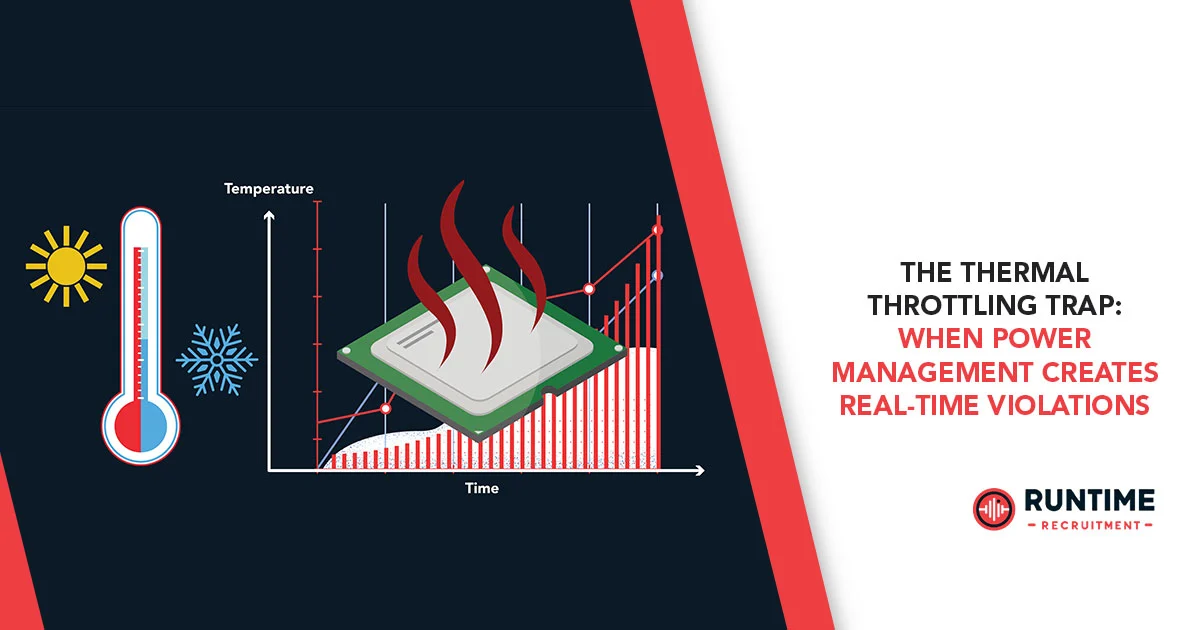In the intricate world of embedded systems, a subtle but dangerous dance unfolds between performance and thermal stability. Engineers strive to squeeze every last drop of performance from their hardware, often pushing components to their operational limits. This drive for efficiency and speed has given rise to sophisticated power management techniques, but one, in particular, poses a critical threat to the very core of real-time systems: thermal throttling.
On the surface, thermal throttling is a hero—a last-resort defense mechanism that protects a system’s central processing unit (CPU) and other components from catastrophic overheating. When a chip’s temperature exceeds a predetermined safe threshold, its thermal management system automatically reduces its clock speed, thereby lowering power consumption and heat generation. It’s an elegant solution for a laptop or a gaming console, where a temporary dip in performance is a minor annoyance. But in the context of embedded systems, especially those that are mission-critical and real-time, this benign-sounding “feature” can become a fatal flaw, leading to unpredictable behavior, missed deadlines, and system failures.
This article delves deep into the thermal throttling trap, exploring its root causes, the insidious ways it undermines real-time performance, and the strategies embedded engineers can employ to escape its clutches.
The Anatomy of Thermal Throttling: A Deeper Dive
At its core, thermal throttling is a direct consequence of the laws of physics. As transistors switch on and off at an incredibly high frequency, they consume power, and that power is dissipated as heat. In the compact, often fan-less enclosures of embedded devices, this heat has nowhere to go. Components like the CPU and GPU are equipped with on-chip temperature sensors. When these sensors detect that the die temperature is approaching its maximum junction temperature ($T_j_{max}$), a built-in thermal management unit takes action.
The action is simple but effective: the clock frequency is reduced. Since power consumption in a processor is roughly proportional to the clock frequency and the square of the supply voltage (P∝f⋅V2), even a modest reduction in frequency and voltage can drastically cut heat dissipation. For a consumer device, this results in a momentary slowdown. A video might stutter, or an application might feel a bit sluggish. The user experience is degraded, but the system remains functional and, more importantly, intact.
In a real-time system, however, the stakes are far higher. A real-time system is defined by its ability to complete tasks within a specific, predictable time frame. The correctness of the system’s output depends not just on the logical result but also on the time at which that result is produced. A late result is, by definition, a wrong result. This is the fundamental tenet of hard real-time systems, and thermal throttling stands in direct opposition to it.
The Real-Time Paradox: When Power Management Becomes a Liability
The primary conflict between thermal throttling and real-time systems lies in the principle of determinism. A real-time operating system (RTOS) and the applications running on it are designed with a full understanding of the system’s performance envelope. Task scheduling, interrupt latency, and worst-case execution time (WCET) analyses are all predicated on the assumption of a stable, consistent clock frequency.
When thermal throttling kicks in, this assumption is shattered. The system’s performance becomes a non-deterministic variable tied directly to its thermal state.
1. The Dynamic Frequency and Voltage Scaling (DVFS) Problem
Many modern processors employ Dynamic Voltage and Frequency Scaling (DVFS) as a power management technique. This allows the system to scale its clock speed up or down based on the current workload. When the system is idle, it can run at a low frequency to save power. When a demanding task arrives, it can ramp up to its maximum frequency to complete the task quickly.
This is where the trap is set. A system can be designed and tested to meet its real-time deadlines under maximum load at its nominal frequency. But what happens if, due to an environmental factor (e.g., a sudden increase in ambient temperature) or a prolonged, high-power workload, the system’s temperature rises and triggers throttling? The processor, which was previously operating at 1 GHz, might suddenly drop to 500 MHz. The WCET of critical tasks, which were carefully calculated based on the 1 GHz frequency, are now irrelevant. A task that was guaranteed to complete in 10 milliseconds might now take 20 milliseconds, causing a real-time violation.
In scenarios where a system needs to react to an event within a strict, non-negotiable deadline (e.g., an airbag deployment system, a medical device, or a flight control system), this non-deterministic performance degradation is unacceptable. The “safe” action of throttling the CPU becomes a direct cause of system failure.
2. The Unpredictable Latency of Shared Resources
Beyond the raw processing power of the CPU, thermal throttling introduces unpredictable latency in the entire system. Consider a system where multiple components—the CPU, a digital signal processor (DSP), and a hardware accelerator—are all on the same die or are tightly coupled. The thermal profile of one component can influence the others.
For example, a sudden, high-intensity computation on the DSP might generate enough heat to cause the entire system’s thermal management unit to throttle the main CPU. This is a classic “neighbor” effect. A high-priority task on the CPU, which was not the source of the heat, is now penalized. Its execution is delayed, and its real-time guarantees are compromised. The thermal throttling of one component creates a domino effect of performance degradation across the entire system.
Furthermore, the throttling mechanism itself can introduce overhead. The software or hardware that monitors temperatures and adjusts clock speeds consumes some of the very processing power it’s trying to manage. This can be a minor issue in consumer devices, but in a resource-constrained embedded system, every clock cycle counts.
3. The Power Management Feedback Loop from Hell
Perhaps the most insidious aspect of the thermal throttling trap is the potential for a vicious feedback loop. Power management algorithms often try to be “smart” by dynamically adjusting performance to save energy. However, if these algorithms are not designed with real-time constraints in mind, they can exacerbate the problem.
Imagine a system that has a high-priority task and a low-priority, but long-running, task. The low-priority task, perhaps a background data logger, runs for an extended period, generating significant heat. This heat triggers thermal throttling, causing the CPU’s frequency to drop. When the high-priority task is then scheduled, it inherits this throttled performance. It takes longer to complete, which means the low-priority task remains in the queue for a longer period, continuing to generate heat and keeping the system in a throttled state. This creates a self-reinforcing cycle of poor performance.
The power management system, in its attempt to be efficient and safe, has actually created a scenario that is both inefficient and unsafe from a real-time perspective. The system is trapped in a low-performance state, unable to recover its full capabilities until the thermal load is reduced, which, ironically, might not happen until the long-running task is finally completed.
Escaping the Trap: Strategies for Embedded Engineers
The solution to the thermal throttling trap isn’t to simply disable the feature. That would expose the hardware to the very risk it’s designed to prevent, potentially leading to permanent damage. Instead, the approach must be proactive, comprehensive, and rooted in a deep understanding of the system’s thermal and real-time profiles.
1. Thermal by Design: The Holistic Approach
The first line of defense against thermal throttling is to treat thermal management as a core design constraint from the very beginning of a project, not as an afterthought. This involves a holistic approach that considers both the hardware and the software.
- Hardware Design: This means selecting components with a lower thermal design power (TDP) for the given performance requirements. It also involves meticulous board layout to ensure proper heat dissipation. Using heat sinks, thermal vias, and strategic placement of high-power components away from sensitive areas can make a world of difference. For high-density systems, passive or active cooling solutions might be necessary. It’s about building a system that can run at its required performance level without approaching the thermal threshold.
- Enclosure and Environment: The physical enclosure of the device and its operating environment are just as important as the silicon itself. An unventilated enclosure will trap heat, leading to inevitable throttling. Engineers must design the enclosure to facilitate airflow and consider the maximum expected ambient temperature of the final application.
2. Predictive and Proactive Power Management
Instead of reactive throttling, which is a defensive measure, embedded engineers can implement proactive power management strategies. These strategies aim to prevent the system from ever reaching a state where throttling is necessary.
- Load Balancing and Task Prioritization: Real-time schedulers can be designed to not only prioritize tasks but also to consider their thermal impact. A scheduler could, for instance, limit the continuous execution of a high-power, low-priority task to allow the system to cool down before a critical, high-priority task needs to run.
- Intelligent DVFS: Instead of allowing the system to ramp up to a high frequency and then suffer a catastrophic drop, an intelligent DVFS policy could cap the maximum frequency at a safe level based on real-time thermal monitoring. This sacrifices some peak performance but guarantees a predictable, deterministic execution time for real-time tasks.
- Predictive Thermal Models: Advanced systems can use predictive thermal models that forecast the system’s temperature based on the current and upcoming workload. This allows the power manager to preemptively scale back performance before the temperature threshold is even breached, ensuring a smooth, predictable response instead of a sudden, jarring performance drop.
3. Software Architectures for Thermal Resilience
The software architecture itself can be a powerful tool in the fight against thermal throttling.
- Minimizing Worst-Case Execution Time (WCET): The most fundamental solution is to make your code as efficient as possible. Shorter execution times mean less time at high power, which means less heat generation. This includes everything from algorithm optimization to using hardware accelerators for specific tasks to offload the main CPU.
- Real-Time Thermal Monitoring and Alarms: The RTOS can incorporate a thermal monitoring service that continuously reads temperature sensors. If the temperature approaches a configurable, non-critical warning threshold, the system can take a planned, graceful action—such as postponing a non-essential task or entering a low-power mode for a brief period—to prevent the system from hitting the throttling threshold. This is a much better alternative to an abrupt, unmanaged performance drop.
- Task Migration: In multi-core systems, it might be possible to migrate a high-power task to a different core that is running cooler, or to a core specifically designated for high-power, non-real-time tasks. This compartmentalizes the thermal load and protects critical tasks from performance degradation.
Conclusion: The Path Forward for Embedded Engineers
The thermal throttling trap is a powerful reminder that in embedded systems, the pursuit of efficiency and performance must be balanced with the unwavering demand for determinism. The reactive, consumer-grade approach to thermal management is a direct threat to the integrity of real-time applications.
For embedded engineers, escaping this trap requires a shift in mindset. It’s not enough to simply write correct code; you must write code that is thermally aware. It’s not enough to select a powerful processor; you must select one that can meet its performance requirements within a realistic thermal envelope. It’s a challenging but essential part of the modern embedded landscape.
By embracing a holistic design philosophy, implementing proactive power management strategies, and building thermally-resilient software architectures, embedded engineers can design systems that are not only powerful and efficient but also reliable, predictable, and—most importantly—safe.
Ready to tackle these challenges?
The complexities of modern embedded systems demand engineers with a deep understanding of these intricate relationships. If you’re a skilled embedded engineer looking for your next challenge, or a company seeking top-tier talent, connect with RunTime Recruitment to explore new opportunities where your expertise can make a real-world impact.









